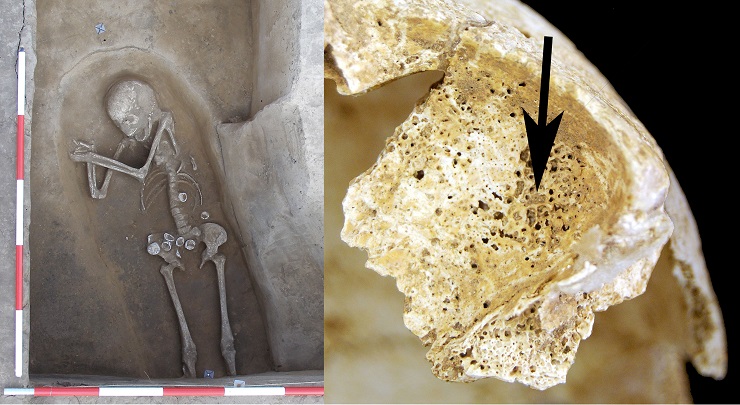Generally emphasised in regard to the transition to agriculture are its social, cultural and technological aspects. This radical cultural change, however, can also be observed on the skeletal remains of the first farmers because the diverse subsistence strategies were also accompanied by the transformation of the physical indications. Compared to the previous hunter-gatherer populations, the figure height decreased and the body structure became more refined. Neolithic food was dominated either by one or by a small number of crops, while the growth of children and adolescents was also disturbed by other stress factors such as viral and bacterial infections or infestations. Evidence of this is the incomplete development of tooth enamel together with microdefects that occurred during childhood and still remained evident in adulthood. Another indicator of episodic stress is the presence of transverse stripes that are visible on radiographs of long bones (i.e. Harris lines). Also recorded in children’s and adult skeletons was an increased frequency of symptoms of anaemia and of worsened dental health. The animals that humans domesticated and that lived in close contact with them represented not only a source of food but also a dangerous reservoir of infection. Worsening of health conditions, the accumulation of refuse and increased population density were favourable mainly for parasites and for the sources of gastrointestinal infections.
 |
| Manifestations of anaemia found on the skeleton of a young woman from a grave of the Stroked Pottery culture (at the Kolín site). The top of her left orbital is perforated with tiny pinholes with their maximum degree of concentration located in the upper left quadrant. |
Findings of trepanned skulls or amputated limbs dating back to the Neolithic indicate that surgical intervention undertaken even in such a distant past did not necessarily need to be fatal. Especially in regard to deliberately opened skulls there is a strikingly similar surgical technique that is utilised in numerous, and often geographically remote, locations (e.g. Ensisheim, Catignano, Trasano, Pendimoun, Grotta Patrizi, Vedrovice and others). In regard to the question of what motivates these acts, their frequent association with fractures of the skull should not be ignored. In a case of this kind the wounds were cleaned, the loose bone fragments were removed and the sharp edges of the broken bones were smoothed. Many deliberately opened skulls do not show any traces of trauma, however, and their arches were trepanned for other reasons. It could be a headache associated with an altered state of consciousness, convulsions, increased intracranial pressure or even an impaired psyche. This risky procedure could also represent a part of a magical ritual of some kind. Despite a number of possible complications - infection, bleeding, damage to the meninges of the brain - the percentage of recoveries is surprisingly high. The mechanical abrasion probably went quickly and professionally, and it is possible that the tool that was used was made immediately prior to the procedure and therefore was less contaminated. Herbal sedatives could have been used for calming, phyto-pharmaceuticals for reducing pain and additional herbal remedies could significantly reduce the risk of infection.
Rarer but proven cases are Neolithic amputations. Indications for performing these could be limbs that have been injured during fight, or because of a fall or an attack by an animal. In these cases sharp stone tools were also probably used and the surgeon would know how to stop the bleeding and to reduce the risk of infection. For example in regard to the left arm of a man from Buthiers-Boulancourt in France he made an incision just above the elbow joint and, based on the absence of any signs of inflammation, even in relatively aseptic conditions. Forearm amputation was also documented in regard to other male skeletons from amongst the Linear Pottery culture in Sondershausen and Vedrovice.
Want to learn more?
- Brůžek, J., V. Černý, and P. Stránská. 2005. Proměny výšky postavy v průběhu věků. Vesmír 84: 165–168.
- Cohen, M. N., and G. J. Armelagos. 1984. Paleopathology at the Origins of Agriculture. New York: Academic Press.
- Cohen, N. M. 1977. The Food Crisis in Prehistory. New Haven and London: Yale University Press.
- Hershkovitz, I., and A. Gopher. 2008. Demographic, biological and cultural aspects of the Neolithic revolution: a view from the southern Levant. In The Neolithic Demographic Transition and its Consequences. In The Neolithic Demographic Transition and its Consequences, eds. J. P. Bocquet-Appel, and O. Bar-Yosef, 441–479. New York: Springer Science/Business Media.
- Larsen, C. S. 1995. Biological changes in human populations with agriculture. Annual Review of Anthropology 24: 185–213.
- Šumberová, R. 2012. Cesta napříč časem a krajinou. Praha: Archeologický ústav AV ČR.
 Archeologické 3D virtuální muzeum
Archeologické 3D virtuální muzeum

.png)